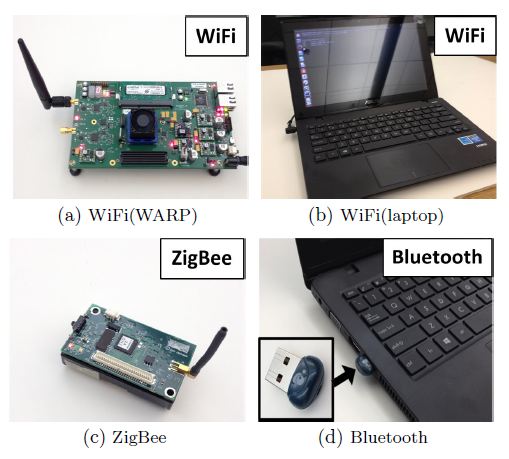Achieving Spectrum Efficient Broadcast under
|
CNS-1444021 |

Project Overview
To mitigate the cross-technology interference, this project aims to address the broadcasting inefficiency for different wireless technologies operating at the ISM band. We will conduct extensive measurement studies on the ISM band to collect the cross-technology interference. With detailed traces, we will build light-weight mathematic models which can precisely capture the characteristics of the wireless channels. With models accurately describing the change of wireless channels, we will propose distributed methods for improving broadcast efficiency under uncontrolled CTI, measurable CTI, and collaborative CTI. The performance of these methods will be validated using both dedicated theoretical analysis and real testbed experiments.
Transparent Link Correlation Layer for Energy Efficient Broadcast

Wireless communication essentially occurs in a broadcast medium with concurrent receptions. Recent works have shown clear evidence that wireless links are not independent and that transmissions from a transmitter to multiple receivers are correlated, a phenomenon that has profound implications for the performance of network protocols such as broadcast, multi-cast, opportunistic forwarding and network coding. In this paper, we show how link correlation can significantly impact broadcast. We present the de- sign and implementation of CorLayer, a general supporting layer for energy efficient reliable broadcast that carefully blacklists certain poorly correlated wireless links. This method uses only one- hop information, which makes it work in a fully distributed manner and introduces minimal communication overhead. The highlight of our work is its broad applicability and effectiveness. Our system effort is indeed significant. We integrate CorLayer transpar- ently with sixteen state-of-the-art broadcast protocols specified in thirteen publications on three physical testbeds running TelosB, MICAz, and GreenOrbs nodes, respectively. The experimental results show that CorLayer remark- ably improves energy efficiency across a wide spectrum of broad- cast protocols and that the total number of packet transmissions can be reduced consistently by 47% on average. This work is published in Mobicom 2013.
Building WiFi radio map with ZigBee sensors

Exploiting the increasing ubiquitous deployment of sensor networks, the paper presents a system called WiBee that utilizes ZigBee sensors to build real-time WiFi radio maps. The design of WiBee is motivated by the observation that a ZigBee radio can sense WiFi frame transmissions although it cannot decode WiFi frames. A sensor passively listens on the wireless channel and estimates the RSS of a WiFi AP at its location. The design of WiBee faces three unique challenges. First, multiple APs may transmit frames concurrently and frame collisions may happen. Second, because of severe resource constraints, a sensor cannot sample the channel at arbitrarily high frequency and hence some frame transmissions may not be sampled. Third, sensor nodes are usually not time synchronized and the on-board clock is inaccurate. To address these challenges, we propose a novel gateway-assisted approach to estimating WiFi RSS values at ZigBee sensors. A light-weight algorithm is designed for identifying the RSS values corresponding to a given AP. It searches the sequence of ZigBee RSS samples for an AP signature sequence. An optimization technique is proposed to address issues of clock drift and time asynchronization. Our extensive experiments on a testbed show that WiBee can achieve low estimation error, short delay and small computation overhead. This work is published in Infocom 2012 mini-conference.
Cross-technology Communication via Free Side-channel

This paper presents FreeBee, which enables direct unicast as well as cross-technology/channel broadcast among three popular wireless technologies: WiFi, ZigBee, and Bluetooth. Our design aims to shed the light on the opportunities that cross-technology communication has to offer including, but not limited to, cross-technology interference mitigation and context-aware smart operation. The key concept of FreeBee is to modulate symbol messages by shifting the timing of periodic beacon frames already mandatory for wireless stan- dards without incurring extra traffic. Such a generic cross- technology design consumes zero additional bandwidth, al- lowing continuous broadcast to safely reach mobile and/or duty-cycled devices. A new interval multiplexing technique is proposed to enable concurrent broadcasts from multiple senders or boost the transmission rate of a single sender. Theoretical and experimental exploration reveals that Free- Bee offers a reliable symbol delivery under a second and supports mobility of 30mph and low duty-cycle operations of under 5%. This work has been reported in ACM MobiCom 2015.